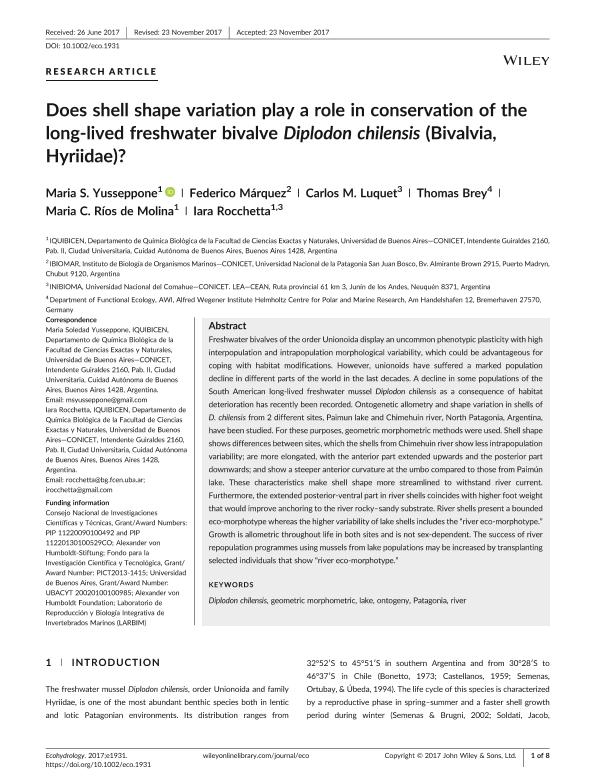Artículo
Does Shell shape variation play a role in conservation of the long-lived freshwater bivalve Diplodon chilensis (Bivalvia, Hyriidae)?
Yusseppone, Maria Soledad ; Marquez, Federico
; Marquez, Federico ; Luquet, Carlos Marcelo
; Luquet, Carlos Marcelo ; Brey, Thomas; Ríos de Molina, María C.; Rocchetta, Iara
; Brey, Thomas; Ríos de Molina, María C.; Rocchetta, Iara
 ; Marquez, Federico
; Marquez, Federico ; Luquet, Carlos Marcelo
; Luquet, Carlos Marcelo ; Brey, Thomas; Ríos de Molina, María C.; Rocchetta, Iara
; Brey, Thomas; Ríos de Molina, María C.; Rocchetta, Iara
Fecha de publicación:
12/2017
Editorial:
John Wiley & Sons Inc
Revista:
Ecohydrology
ISSN:
1936-0584
e-ISSN:
1936-0592
Idioma:
Inglés
Tipo de recurso:
Artículo publicado
Clasificación temática:
Resumen
Freshwater bivalves of the order Unionoida display an uncommon phenotypic plasticity with high interpopulation and intrapopulation morphological variability, which could be advantageous for coping with habitat modifications. However, unionoids have suffered a marked population decline in different parts of the world in the last decades. A decline in some populations of the South American long-lived freshwater mussel Diplodon chilensis as a consequence of habitat deterioration has recently been recorded. Ontogenetic allometry and shape variation in shells of D. chilensis from 2 different sites, Paimun lake and Chimehuin river, North Patagonia, Argentina, have been studied. For these purposes, geometric morphometric methods were used. Shell shape shows differences between sites, which the shells from Chimehuin river show less intrapopulation variability; are more elongated, with the anterior part extended upwards and the posterior part downwards; and show a steeper anterior curvature at the umbo compared to those from Paimún lake. These characteristics make shell shape more streamlined to withstand river current. Furthermore, the extended posterior-ventral part in river shells coincides with higher foot weight that would improve anchoring to the river rocky–sandy substrate. River shells present a bounded eco-morphotype whereas the higher variability of lake shells includes the “river eco-morphotype.” Growth is allometric throughout life in both sites and is not sex-dependent. The success of river repopulation programmes using mussels from lake populations may be increased by transplanting selected individuals that show “river eco-morphotype.”
Palabras clave:
Diplodon Chilensis
,
Geometric Morphometric
,
Ontogeny
,
Patagonia
Archivos asociados
Licencia
Identificadores
Colecciones
Articulos(IBIOMAR)
Articulos de INSTITUTO DE BIOLOGIA DE ORGANISMOS MARINOS
Articulos de INSTITUTO DE BIOLOGIA DE ORGANISMOS MARINOS
Citación
Yusseppone, Maria Soledad; Marquez, Federico; Luquet, Carlos Marcelo; Brey, Thomas; Ríos de Molina, María C.; et al.; Does Shell shape variation play a role in conservation of the long-lived freshwater bivalve Diplodon chilensis (Bivalvia, Hyriidae)?; John Wiley & Sons Inc; Ecohydrology; 12-2017; 1-8
Compartir
Altmétricas



